A Fabergé Scythian-style gold bracelet made by Erik Kollin sold for $64,485. Over 300 photographs, many signed by members of the Imperial family, realized 50 times the starting price with a total yield of $1.73 million. The collection belonged to Ferdinand Thormeyer, who for three years was the French tutor to Crown Prince Nicholas and his brother George Alexandrovich. More than 2000 private letters, postcards, drawing and photographs from the same source sold in December of 2010.

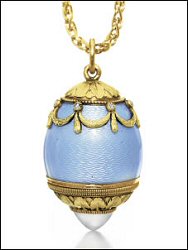
Fabergé Frame and Egg Scent Bottle
(Courtesy Christie’s)
The Collection of Elizabeth Taylor: Jewelry (Part II)
A frame with a photograph of Elizabeth Taylor and Malcolm Forbes sold for $194,500, or almost 13 times the high estimate. A pendant egg designed as a scent bottle brought $182,500, or 30 times the high estimate of $6,000.
An updated listing of Fabergé and Russian Auction Catalogs, magazines and books available to collectors has been published by Jeffrey Eger.
1887 Third Imperial Egg (Whereabouts Unknown)
Discovery of an auction catalog entry (March 6-7, 1964 Parke-Bernet, New York) in July 2011 by Anna and Vincent Palmade.
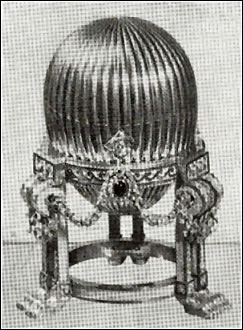
1887 Third Imperial Egg
(Courtesy Parke Bernet)
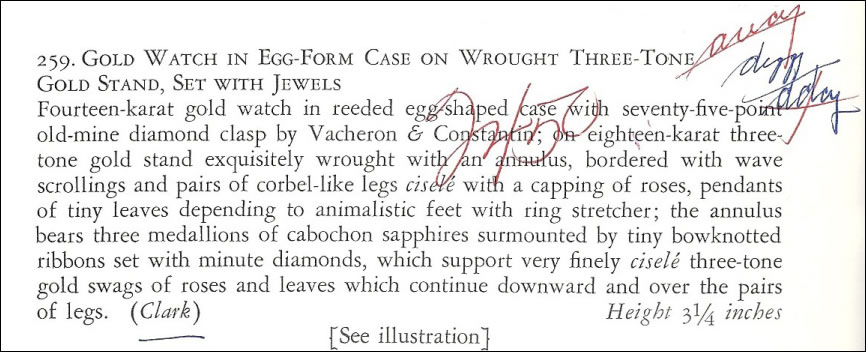
Priced Auction Catalog Entry
(Courtesy of Jeffrey Eger)
1888 Cherub Egg with Chariot (Whereabouts Unknown)
Sketch is based on a photograph of the von Dervis Mansion exhibition in 1902.
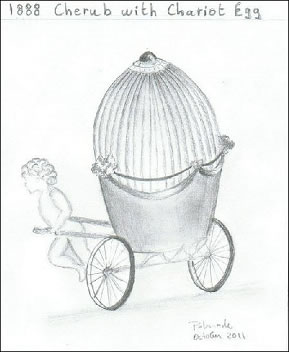
(Courtesy Anna and Vincent Palmade)
Since its initial presentation the Imperial Easter Egg has only been seen in five exhibitions in over a hundred years – von Dervis Mansion, St. Petersburg (1902), Victoria & Albert Museum, London (1977), Museum of Applied Arts, Helsinki (1980), Cooper-Hewitt Museum, New York (1983), National Museum, Stockholm (1997), and twice at auction in 1960 (£2,400) and 2003 (passed in or withdrawn at $1.3 million). Early in 2013 the Diamond Trellis Egg will be exhibited at the Houston Museum of Natural Sciences in Texas through the generosity of the new owners.
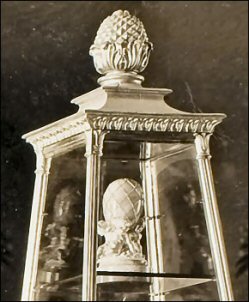
von Dervis St. Petersburg (1902)
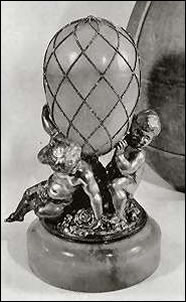
Sotheby’s London (1960)
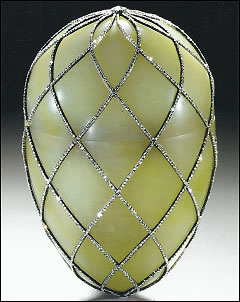
Christie’s New York (2003)
Carol Warner, Washington (DC):
(Updates are posted in Exhibitions on the Fabergé Research Site)
Fabergé from the Matilda Geddings Gray Foundation Collection
The five-year loan from the Matilda Geddings Gray Foundation Collection is on view on a rotating basis in a popular spot in the European Sculpture and Decorative Arts Gallery in accordance with Matilda Geddings Gray’s expressed wish that a wide public should enjoy the collection. Prior to going on display, some pieces underwent a light professional cleaning thanks to the work of the Metropolitan Museum’s conservators. (Courtesy Valeria Cafa)
March 23 – May 20, 2012 Art Museum Riga Bourse, Riga, Latvia
The newest museum in Riga in its Fabergé exhibition is featuring works from the St. Petersburg and Moscow shops. (Courtesy Paul Kulikovsky, Romanov News)
Fabergé Exhibitions during Queen Elizabeth’s Diamond Jubilee Year:
Treasures from the Queen’s Palaces
A diamond-studded Fabergé notebook packed with autographs and a handwritten note dated June 21, 1897, by Queen Victoria, and two Easters eggs will be part of twenty Fabergé objects on display.
March 31 – June 17, 2012 Harewood House in Yorkshire, United Kingdom
Royal Harewood, Celebrating the Life of the Yorkshire Princess
Fabergé objects from the Harewood Collection, for 40 years the home of Princess Mary, The Princess Royal, are supplementing a collection of photographs lent by The Queen from the Royal Collection.
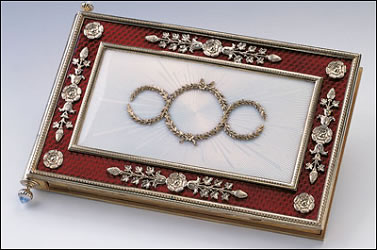
Queen Victoria’s Fabergé Notebook
(Courtesy The Royal Collection)

Fabergé Bonbonniere
(Courtesy Wartski)
A Diamond Jubilee Tribute, Fabergé from a Private Collection
Studies of animals and flowers from a collection of over 150 works assembled over 35 years will be on view in aid of The Samaritans. Thomas Moore, Sr., an anglophile who lives in the United States, in his blog shares a one-of-kind inside view of Wartski at 14 Grafton Street.
The Allure of Fabergé: Selections from the Dorothy and Artie McFerrin Collection
Fabergé objects selected from the McFerrin Collection will be the first of two traveling exhibitions from this extensive collection recently formed. Fifty objects, most of them not shown in exhibitions before, will be complemented by a companion venue recreating flower arrangements from the opulent years of the Romanov reign of the last tsar
August 1, 2012 for approximately 2 years Virginia Museum of Fine Arts, Richmond
Fabergé Galleries will close for an international tour and major renovations of the space.
October 14, 2012 – January 20, 2013 Detroit Institute of Arts, Michigan
Designing Luxury from the Virginia Museum of Fine Arts
More than 200 objects including four Imperial Eggs from the Pratt Collection of the Virginia Museum of Fine Arts in Richmond will be on display. (Courtesy Yao-Fen You)
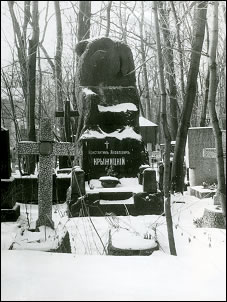
Grave of Konstantin Krijitski
(Courtesy of Galina Korneva)

1913 Photo of the Original Monument
by Maria Dillon
On December 6, 2011, a plaque honoring Carl Fabergé (1846-1920) was unveiled at 15 Khreshchatyk Street in Kiev, Ukraine. It is at the location of the Kiev Fabergé shop in existence from 1905-1910, and then merged with the Odessa branch of the firm. (Courtesy Paul Gilbert, Royal Russia)
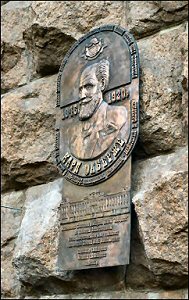
Fabergé Plaque in Kiev
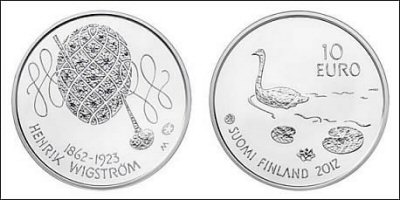
Fabergé Coin
(Courtesy Mint of Finland)

Fabergén suomalaiset mestarit

TEFAF Maastricht
(Courtesy John Jenkins)
Caroline de Guitaut, curator of decorative arts at the Royal Collection in England and the author of three books on Fabergé, will present a lecture entitled, Fabergé and the Royal Collection, to honor the legacy of Frederick J. Fisher, Hillwood’s executive director for 20 years (1990-2010). A book signing will follow.
The Shuvalov Palace, situated on the Fontanka River 21, St. Petersburg, is being renovated under the auspices of the Cultural and Historical “The Link of Times” Foundation founded by businessman Viktor Vekselberg. The restoration is to be complete by the end of 2012 and plans are to install a Museum of Fabergé as a permanent exhibition selected from Mr. Vekselberg’s collection. (Courtesy Paul Kulikovsky, Romanov News)
The State Hermitage Museum in 2014 plans to open a Carl Fabergé Museum in the largest of three rooms in the East Wing of the General Staff Building to coincide with the 250th anniversary of the Hermitage in St. Petersburg, Russia. The Hermitage’s collection of Fabergé includes models of the Imperial regalia for which Fabergé was awarded first prize at the Paris World Exhibition in 1900 – a rock crystal dish, a silver lamp, a necklace with precious gems. Some items have been restored and are currently on view in the Hermitage’s Treasure Gallery. A large collection of sketches from the House of Fabergé created during a period of 25 years includes drawings by Carl Fabergé’s brother, Agathon Fabergé. An electronic catalog of the museum’s art collection (at present only for internal use) and a new website are being developed in partnership with IBM in time for the celebration.
The Virginia Museum of Fine Arts plans to take its signature collection of Fabergé jewels on a two-year tour starting after August 1, 2012, while more than doubling the size of the museum gallery where the works are displayed. The museum has committed to keeping sole custody of the jewels during the tour to satisfy the terms of the 65-year-old will that bequeathed to the museum the fabled collection of Lillian Thomas Pratt … It is the largest collection of Fabergé eggs outside Russia itself.
Pratt’s 1947 will states that the items cannot be sold or loaned, but the museum devised a court-approved arrangement in 1995 that allowed part of the collection (52 objects) to be shown concurrently with the Fabergé in America exhibition in 1996. Museum officials said they expect the 150 items in the Fabergé collection to be displayed in four or five cities in North America and Europe. (Source: Michael Martz, Richmond Times-Dispatch, January 5, 2012)
Skurlov, Valentin V., Tatiana Fabergé, Ekaterina Demkina, and Sergey Kvashnin. Михаил Перхин. Ювелир фирмы Фаберже. Кавалеры ордена Михаила Перхина. (Mikhail Perkhin – Jeweler Fabergé), 2011. In Russian.
The first in a new series of books to be entitled, Life of Famous Jewelers, with detailed research by Valentin V. Skurlov includes facts about the life of Mikhail Perkhin (1860-1903), senior workmaster of the Fabergé firm. Under Perkhin’s leadership about 28 of the Imperial eggs were created. The biographical data in the book also contains 222 biographies of world-class jewelers selected from 16 countries who have been awarded the Order of Perkhin – established in modern times. A lengthy blog by Mr. Skurlov details his findings. (Courtesy of Anna and Vincent Palmade)

1893 Fabergé Catalog
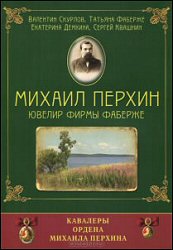
Mikhail Perkhin – Jeweler Fabergé
Who remembers the tinplated ‘Fabergé’ eggs? They were the rage in museum gift shops and mail order catalogs in 1990’s and became part of the popular culture. Two readers who did remember sent these notes:
Immensely popular once again a few years ago – sold with chocolates at airports and gift shops worldwide. I had masses of them, but can only find the Mosaic egg right now!
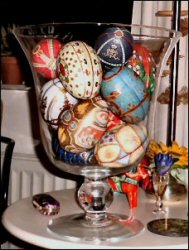
Tinplated Eggs
Gala Auction for of the Winston Churchill Memorial and Library Featuring Works of Art and Items of Interest and Originality
Attended by 400 specially invited guests at Westminster College, Fulton, Missouri, the auction included a fluted cigarette case (price realized $2,500) and a silver coffeepot with a hinged cover ($2,750). Of particular interest is the monogram on the cigarette case. A search to verify the monogram and crown confirmed it to be that of Grand Duke George Alexandrovich (1871-1899), younger brother of Nicholas II, who is commemorated on the 1893 Caucasus Egg. He suffered from tuberculosis and died young in a motorcycle accident.

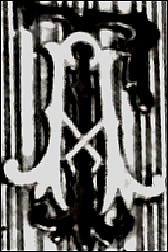
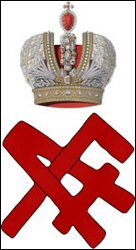
Monogram Verification
(Courtesy Sotheby Parke Bernet and Wiki)
